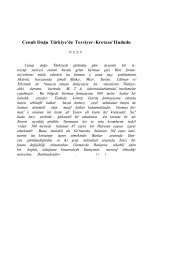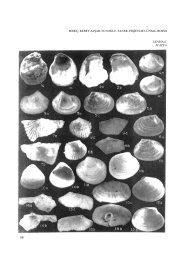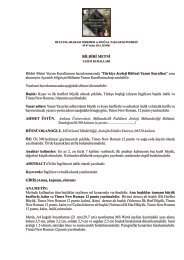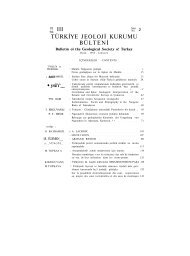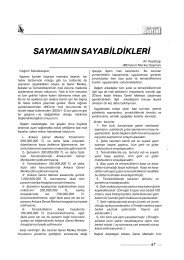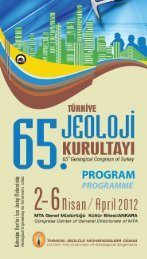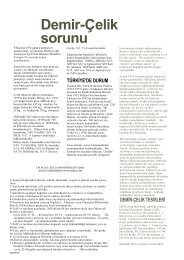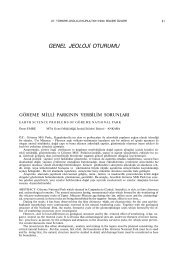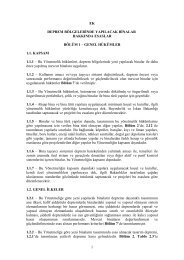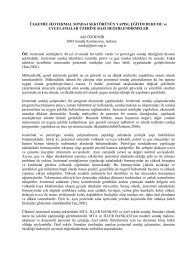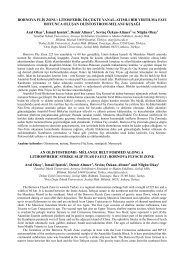Paleosismoloji ve Arkeosismoloji Palaeoseismology and ...
Paleosismoloji ve Arkeosismoloji Palaeoseismology and ...
Paleosismoloji ve Arkeosismoloji Palaeoseismology and ...
You also want an ePaper? Increase the reach of your titles
YUMPU automatically turns print PDFs into web optimized ePapers that Google loves.
62 nd Geological Kurultai of Turkey, 13−17 April 2009, MTA–Ankara, Türkiye<br />
North Anatolian Fault on Hersek Peninsula, Turkey: Its Geometry <strong>and</strong><br />
Implications on 1999 İzmit Earthquake Rupture Propagation<br />
Özgür Kozacı 1 , Erhan Altunel 2 , Scott Lindvall 1 , Charlie Brankman 1 & William Lettis 1<br />
1 William Lettis & Associates, Inc., Walnut Creek, CA 94596, USA<br />
(E-mail: kozaci@lettis.com)<br />
2 Eskişehir Osmangazi Uni<strong>ve</strong>rsity, Engineering Faculty, Department of Geological Engineering,<br />
Meşelik, TR−26040 Eskişehir, Turkey<br />
Seismic hazard awareness has shifted to the seismic potential of the Marmara region, becoming a<br />
newly identified area of concern following the destructi<strong>ve</strong> 1999 North Anatolian fault earthquakes.<br />
Regional high risks result from dense population <strong>and</strong> concentrated regions of industrial de<strong>ve</strong>lopments<br />
in close proximity to one of the most acti<strong>ve</strong> strike-slip faults in the world, making hazard assessment<br />
critical. Howe<strong>ve</strong>r, inherent complexities associated with the offshore section of the North Anatolian<br />
fault has made assessing the regional seismic hazard extremely challenging. One approach to<br />
determine the potential size of an earthquake requires the knowledge of rupture length <strong>and</strong><br />
displacement amounts on a gi<strong>ve</strong>n fault. In order to determine the surface rupture length we need to<br />
know which fault segment(s) are likely to experience surface rupture during the next big earthquake.<br />
Numerous offshore <strong>and</strong> modeling studies performed o<strong>ve</strong>r the Gulf of İzmit suggest that the 1999<br />
rupture continued west of the terminus of surface rupture near Hersek. These findings, howe<strong>ve</strong>r, do<br />
not coincide with the lack of surface rupture obser<strong>ve</strong>d at Hersek peninsula during the most recent<br />
earthquake. This observation indicates the importance of underst<strong>and</strong>ing the fault geometry at this<br />
particular site in order to underst<strong>and</strong> the western termination of the last <strong>and</strong> possibly the eastern extent<br />
of the next surface rupture. We aimed our efforts at resolving the fault geometry on the Hersek<br />
peninsula by applying geomorphic analyses, palaeoseismic trenching, geophysical sur<strong>ve</strong>ys, <strong>and</strong><br />
archaeo-seismological approach in the field. Our studies provided evidence for past surface ruptures as<br />
well as demonstrating a restraining step-o<strong>ve</strong>r/bend on the North Anatolian fault in the vicinity of<br />
Hersek peninsula. We tested this fault geometry with a finite element model in half elastic space <strong>and</strong><br />
correlated the results successfully with the existing topography. Such fault geometry combined with<br />
the evidence of past surface ruptures implies that the 1999 İzmit earthquake surface rupture was<br />
arrested at this location. Our results suggest that the next large earthquake surface rupture in the<br />
Marmara region will probably include the Yalova segment <strong>and</strong> extend as far east as the Hersek<br />
peninsula.<br />
Key Words: North Anatolian Fault, fault geometry, rupture arrest<br />
1005



